Walking through the Cabelas Gun Library recently, a pistol caught my eye. A base model Colt Government Model Series 80 normally wouldn’t get a second look. It’s not that I don’t like them, it’s because I already have them, and I know the guns well enough.
The USGI configuration Colt is what I compare all other 1911s to. Not as an ideal, but an average. A basic Colt 1911 is what I consider a perfectly mediocre 1911. And that’s pretty good.
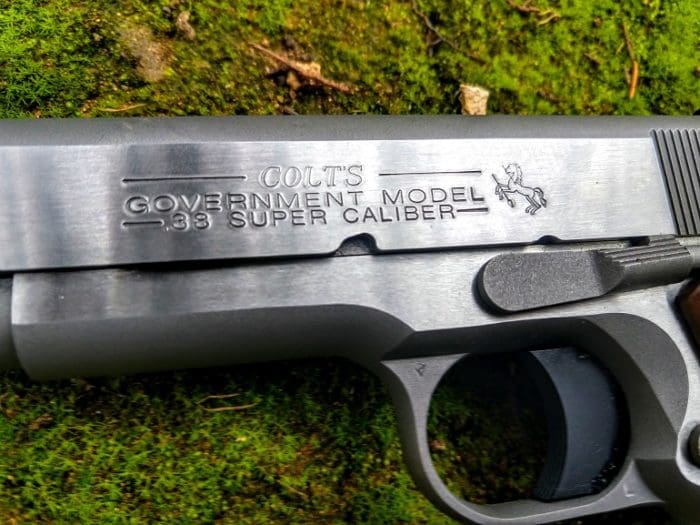
This stainless steel model was unusually well polished for a base model, but that wasn’t it either. A pair of numbers and two simple words kept my attention. “.38 Super Caliber” was neatly stamped on the left side of the slide.
The .38 Super, in one form or another, has been around almost 100 years. It has a lot going for it, but bad timing and America’s general infatuation with bigger projectiles has always kept it from being more popular. Almost a century later, the .38 Super still has a relatively small but dedicated following. It’s a fast, flat-shooting round with a lot of potential for deep penetration, mild recoil, and the more modern chamberings provide great reliability and exceptional accuracy.
A higher pressure version of Browning’s .38ACP, the .38 Super gained popularity when shooters realized they could take advantage of the new 1911 pistol. The 1911 was capable of handling higher pressures than the older M1900. Way back then, people figured out that a lighter bullet traveling faster could produce less recoil and a plenty of energy delivered on target.
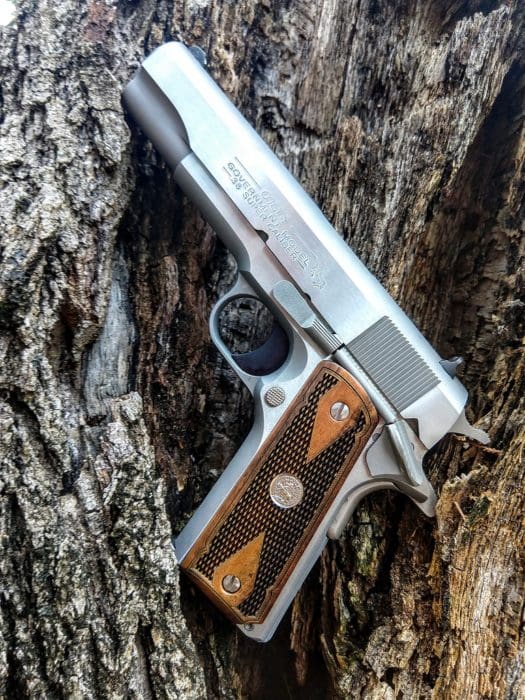
By 1933, Remington was putting out a .38 Super load for the Colt 1911 pushing a 130gr round at 1,300fps. Nowadays, Remington is selling the same 130grain bullet, but it’s moving about 100fps slower. Armscor sells a dirt cheap ($14.75 for 50 rounds) .38 Super pushing a 125grain bullet at 1,200fps. SIG’s V-Crown is pretty much the same, but Buffalo Bore is pushing that same weight at an advertised 1,450fps.
Does that sound a whole lot like the .357 SIG? It should. With most commercial rounds, as well as what’s in the reloading manuals, the fastest 124-130 grain loads for the .357 SIG run between 50 and 75fps slower than out of the .38 Super. Not much. For the 115gr loads, you’ll see even less variation, if any at all.
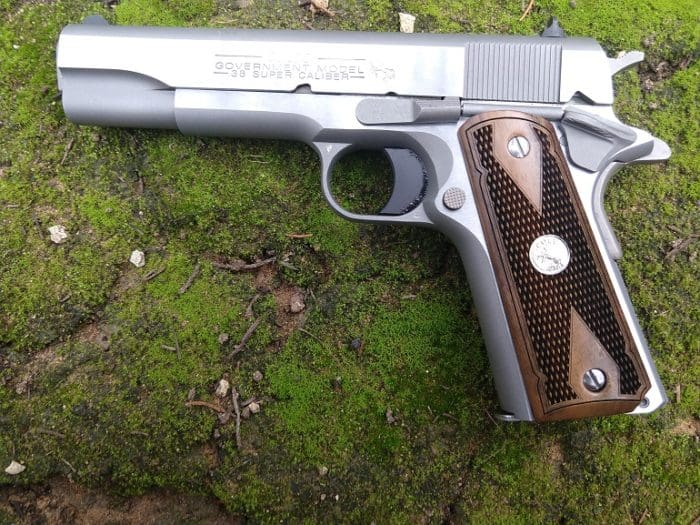
There are some outliers with the right bullet weight and the right powder. Take a look at Accurate No 7’s, loadings for the .38 Super. 1,300fps with a 147grain bullet. That’s just under 100fps faster than I can find any 147gr .357SIG load, with any powder.
The .38 Super can also launch a 158g round at about 1,150fps and still say well below the SAAMI maximum. I can’t find any safe load data for the .357 Sig with that heavy of a round.
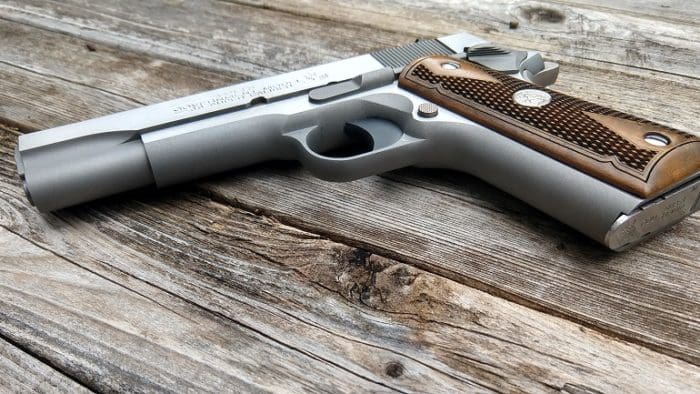
The .38 Super significantly outperforms the .38 Special, even in similar length barrels. The .38 Super is not a semi-auto .357 Magnum. Yes, with the 125gr load, both the .38 Super and the .357 Magnum can generate equal velocities with the same barrel length. That’s impressive for a semi-auto pistol with a SAAMI max pressure of 36,500PSI.
But with the heavier bullets the .357 Magnum is capable of firing, the old wheel gun has a clear advantage. With any barrel length of four inches or greater, the .357 Magnum can launch a 180gr round as fast as the .38 Super can send a 130grain round.
Originally, the cartridge headspaced off the diminutive rim of the .38 Super, leading to less-than-stellar accuracy. The power was all there, just not the precision. Fortunately, shooters like the legendary Brian Enos looked at the .38 Super and saw it for all its potential.
Soon enough, barrel makers like (the even more legendary) Bar-Sto Precision started making barrels that allowed the case to headspace off the case mouth instead of the inadequate rim. The accuracy, as well as some ignition issues, were solved. Ever since then, manufacturers have made the switch to headspacing off the case mouth.

Now the cartridge had adequate power and accuracy. When it came to the competition scene, the .38 Super ruled all for decades. The real gains came when running the .38 Super hot with a compensator. All that gas drove the muzzle back down. The much lighter bullet weight, combined with the comp, allowed shooters to reach Major power factor while firing a gun with less recoil at blistering speeds.
How hot were some of those loads? Super hot. There aren’t enough pluses in +P+++ to get there. Some of those loads hit over 50,000PSI. It would be a serious mistake to attempt to fire rounds loaded that hot in any firearm not specifically designed to do so.
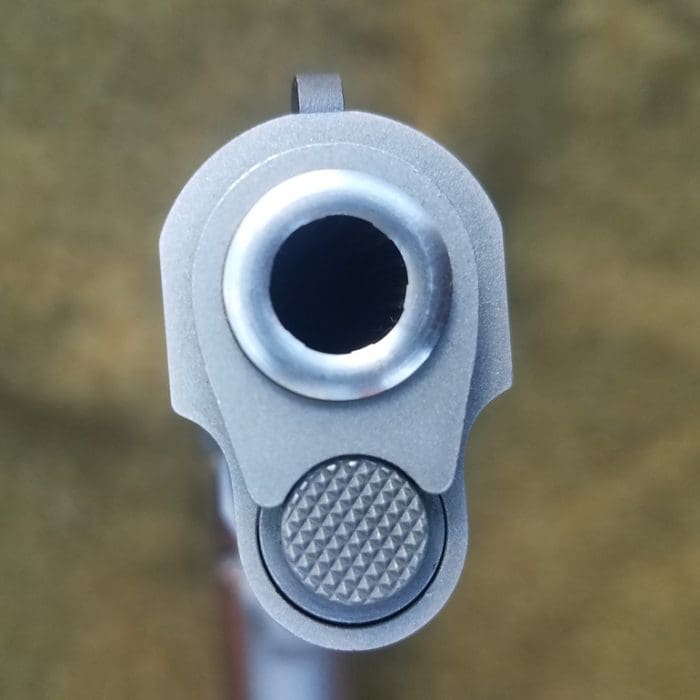
The .38 Super has remained popular to this day with competition shooters whether they are shooting the super-duper hyped up loads, or just the already plenty fast rounds within the SAAMI limits.
There are a few major manufacturers that still make a limited number of .38 Super guns in their line of 1911s. Colt is one of them.
This particular gun is a Series 80 pistol. The Series 80 guns set out to fix a problem that really never existed in the real world, namely, making the 1911 drop-safe. Essentially, the Series 80s actively block the firing pin unless the trigger is pulled. The falling gun’s inertia alone won’t bring the pin forward.

The Series 80 safety system consists of five basic parts. A modified firing pin, a firing pin lock plunger and spring, the firing pin plunger lever (seen protruding above from the frame and behind the slide) and the trigger bar lever.
When the trigger is pulled, the trigger bow elevates the trigger bar lever, pushing the firing pin lock plunger lever to push the firing pin lock plunger up, unlocking the firing pin and allowing it to move forward.
I may be the only person on Earth who actually prefers the Series 80 guns. I have seven Colt 1911s and most of them are Series 80 guns and it has nothing to do with them being drop safe. In disassembly, you have to lock the firing pin inward prior to removing the firing pin stop plate. That firing pin lock plunger keeps the firing pin in, which means I’m less likely to shoot the firing pin across the room during disassembly.
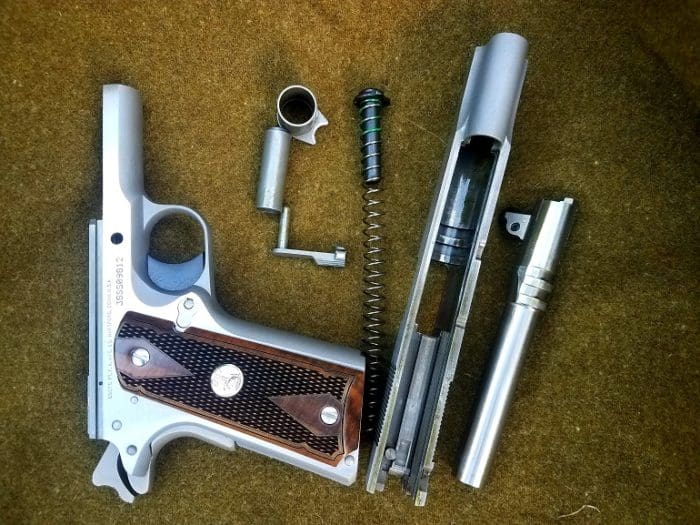
There are some concerns with the Series 80 and reduced reliability. Extensive frame wear would eventually cause the firing pin lock plunger lever to fail to connect with the plunger. Because of this, as well as simple differences in slide-to-frame fit on different models, multiple-size firing pin lock plunger levers are available.
I don’t know at what point this becomes an issue, as I’ve never actually seen a 1911 have enough wear to make a difference. I have a Colt Combat Elite with well over 30,000 rounds through it and this is not an issue yet. If it is, the part costs all of $3 and is easy to replace.
This is a USGI configuration pistol. The frame and slide size, barrel, guide rod, controls, hammer, sights, everything but the Series 80 specific parts and the stainless steel are pretty much as basic as it gets. This is the basic model Colt.
The basic Colt gets you basic sights. They’re simple white three-dot sights. The front is fixed and well staked. The rear sight is drift-adjustable. There is no elevation adjustment available. Out of the box, the gun shot dead on with a 130gr round moving at 1,200fps at 25 yards.
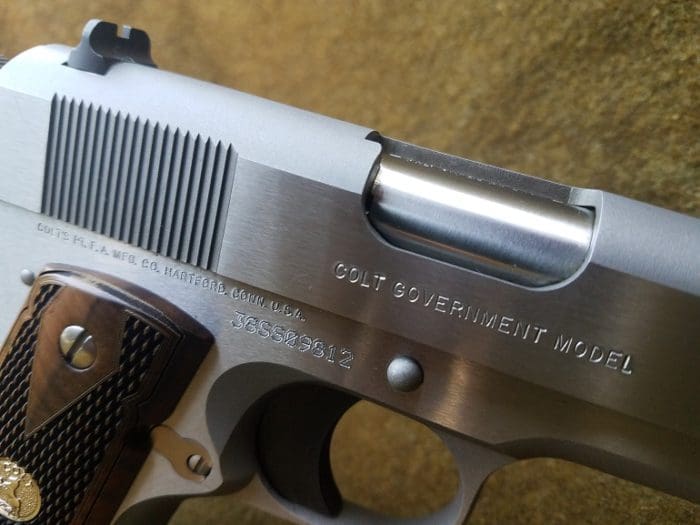
The ejection port is lowered, but not flared, as on several other Series 80 models. There are no front cocking serrations. There don’t need to be.
This basic brushed stainless model also comes with a standard spur hammer and a standard grip safety, without a memory bump. Enhanced beaver-tail safeties have become so common on just about any 1911 that they are more common than the old style, and for good reason. The standard safety, like this one, can dig into the web of the thumb for a lot of shooters, especially if they have thick hands.
I’ve never had much of a problem with this safety in recoil, and even less so in the softer recoiling calibers, like the 9x19mm or this .38 Super.

The grips included with this pistol are bendable black soft rubber, somewhat decorated with checkering and stamped with the Colt pony logo. I replaced them with a set of quality walnut grips with a silver Colt medallion almost immediately. The original grips aren’t good and the photo above shows them in their natural habitat.
There’s no externally available adjustment for over-travel in the solid trigger.

Looking at the back of the gun, the slide-to-frame fit is less than ideal. Still, the gun feels tight, and as we’ll see below, shoots well. As such, there’s no need to have it addressed. The barrel crown is smooth and polished and the barrel fit is excellent.
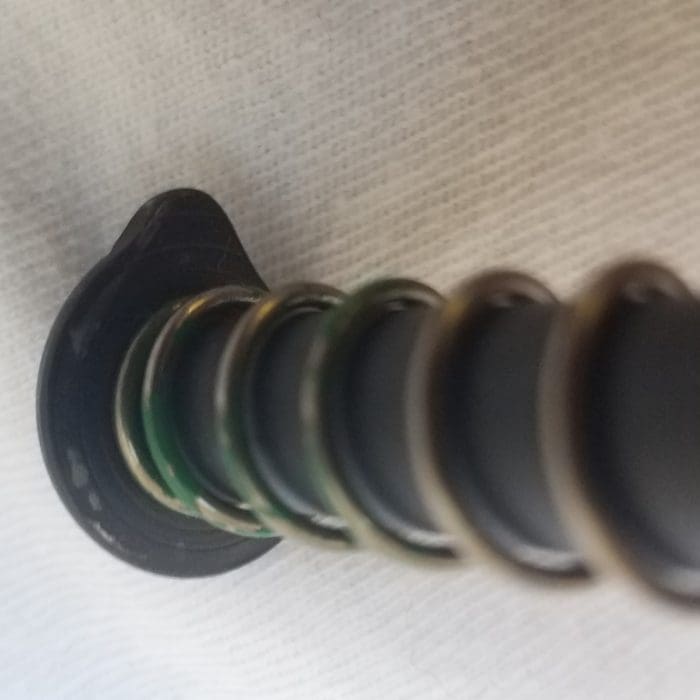
The firing pin stop plate is slightly out of dimension. It’s not overly loose, and it poses no real reliability concerns, but it does make reassembly a little difficult and is so easy to replace or fix I’ll see to it. The plate is also pretty rough around the firing pin port, something I’ll fix as well. Finally, the finish on the GI-style guide rod is already chipping and scratched, even on a new gun.
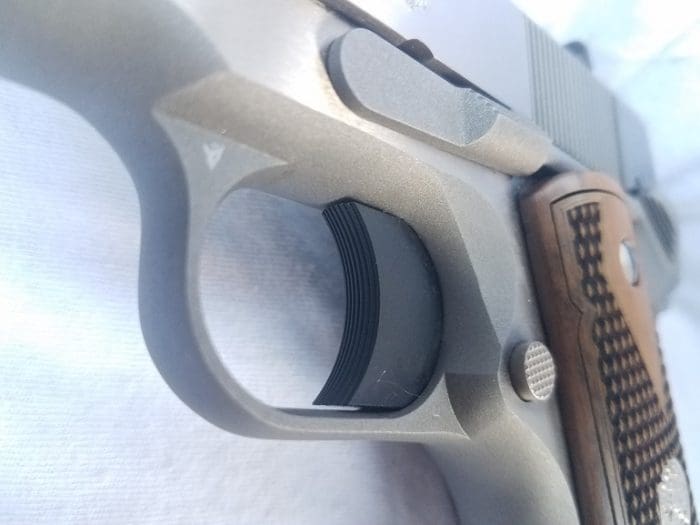
I’ve never found a bad trigger on any Series 80 Colt, but some are much better than others. Trying this trigger out in the store is one of the reasons I bought this gun in the first place. After some empty slack, there is a teeny bit of squish, followed by a light clean break. Lighter than most new Colts.
Putting it on my Lyman scale confirmed what I was feeling in the store. This pistol’s trigger breaks at an extremely consistent 3lbs, 4oz. That’s lighter than where most of my 1911s started stock, but closer to where I eventually put them. My EDC 1911 triggers are usually 3lbs or slightly less.
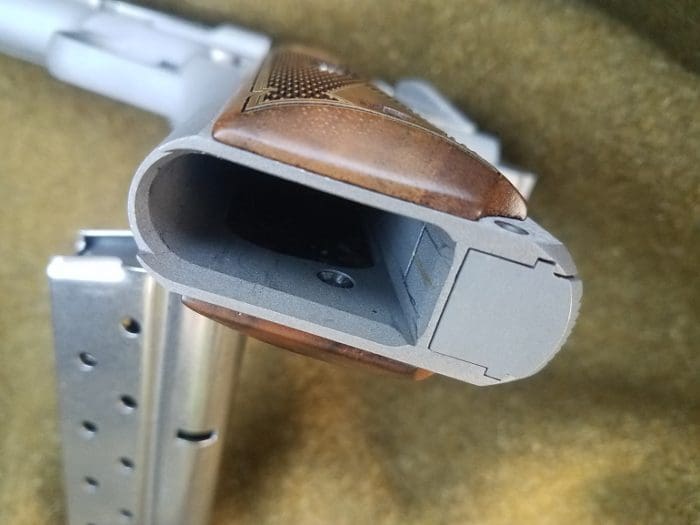
The magazine well is slightly beveled. When inserting a magazine, you’ll need to take some care otherwise the mag will get hung up on the edge of the grip. It takes a good push to seat the magazine, as it wants to stop about halfway into the well.
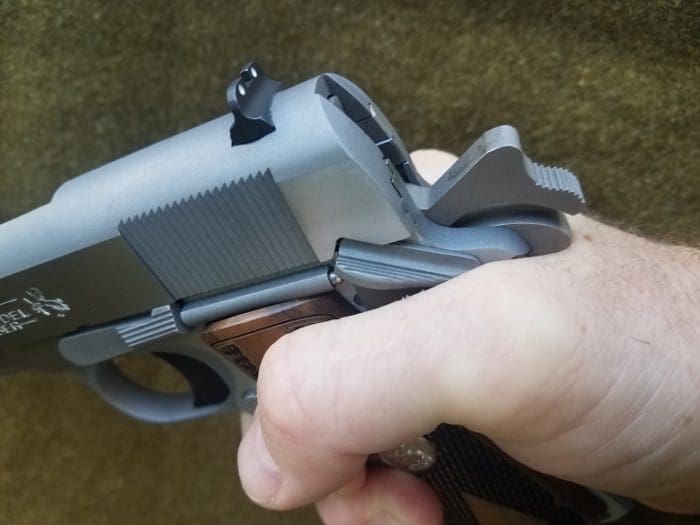
None of the edges of this Colt have been smoothed out, but there are also no burrs anywhere on the gun either. After long strings of shooting or carrying IWB for about a week, I experienced no cuts, scratches, bruises or was otherwise uncomfortable with this basic gun.
What’s not basic about this pistol is the finish. But it’s supposed to be. This is Colt’s bottom of the line “brushed stainless steel finish.” Normally, I wouldn’t particularly like that finish on a gun. I really dig a brushed stainless frame with a blued slide. If it’s going to be all stainless, I prefer a little more polish.
For some reason, this gun has it. It’s hard to tell in the photos, but this gun’s overall level of finish is a solid step up from most of the basic brushed stainless Colts. Not to say they are usually bad, they aren’t at all. This one is just particularly good.

A stock Colt pistol barrel has a drawback for the higher pressure cartridges in that it doesn’t fully support the case all the way back. Take a look at the photo above and you’ll see a space there at the bottom of the breach where the case isn’t surrounded by the barrel.
That’s what a standard Colt barrel looks like. When firing loads nearing the maximum SAAMI pressure, that section where the case is exposed can weaken and bulge. In the worst-case scenario, the case will rupture during ignition. That’s not good.
If you really want to step up to a regular diet of high pressure loads, you’ll need to purchase a fully supported barrel and have a competent gunsmith install it. Alternatively, you could just buy better brass. Starline makes 38 Super +P brass for $.17 a case. It’ a little thicker around web and base.
I loaded up Starline 10 Starline cases with a 147gr Hornady XTP bullets and pushed it with 9 grains of Accurate No. 7. According to the Western Powder’s Loading Guide, that should give me just over 1,200fps and still keep me under the pressure maximum. I shot all 10, inspected the cases, and reloaded then and shot them all again. Then I did it again and inspected the cases. There were no signs of case bulging or other issues.
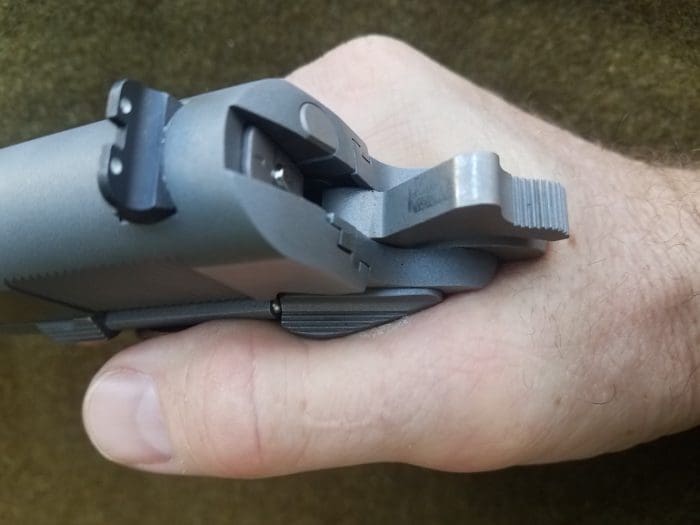
Even with these higher energy rounds, the pistol is very easy to shoot. It doesn’t quite feel like the cheating joy of shooting a 9x19mm in a Government-sized 1911, but it does feel noticeably lighter than a 230gr standard .45ACP load.
That lack of recoil leads to some very fast shooting, with minimum muzzle rise. It’s also nice to be able to throw out 10 rounds of ammunition in a single stack gun, each of those rounds producing as much as 500 ft-lbs of energy. Fatigue sets in a lot later for me with the .38 Super.
The good news is .38 Super ammunition is easy to find. I checked three local gun stores, and all of them carried at least one load for the cartridge. Cabelas in Buda, Texas had four. Most of the major manufacturers make .38 Super loads, and specialty ammunition companies do as well.
That’s great, but sadly, most of the factory loads are fairly anemic. It takes a reloader to really wring all of the power available out of the cartridge. If you’re only seeing “.38 Super +P” on the shelf, have no fear. According to my Sierra Loading Manual, most ammunition manufacturers added the +P designation back in 1974 in order to further differentiate the round from the lower pressure .38 ACP.
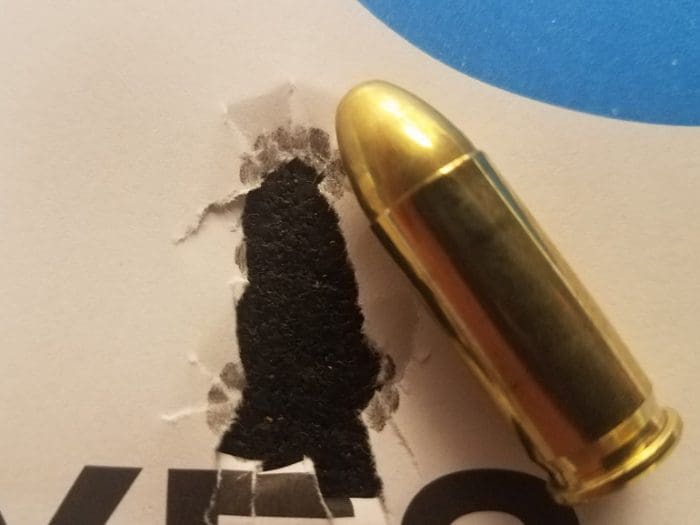
Of the commercial rounds I found at Cabelas, the Armscor round shot the best. This round grouped at an average of 9/10th of an inch. Let me put write that again. The cheap Armscor 125gr grain bullet shot a five round group just under one inch at 25 yards, averaged over four strings.
That commercial round actually outperformed anything else I could put through the gun, including my own hand loads. The SIG-V Crown round shot an average 1.4″ group, and the PPU 130gr FMJ shot the worst group, at 1.6.” My almost max pressure 147gr hand loads, producing about 500ft/lbs of energy scored 1.2.”
That Armscor round really surprised me. It’s good ammo, and has scored well in many of my reviews, but sub-1″ for an average group out of a bone stock, base model Colt is much better than I would expect. Probably twice as good.
None of the ammunition I fired, commercial or hand loads, in any weight, ever were as large as 2″. Again, the Colt’s aren’t bad guns, quite the opposite, but that is precision that this model of Colt is not particularly known for.

The .38 Super is known to be a round that feeds well in the 1911 platform. (Very few pistols are made for the .38 Super other than the 1911.) This pistol would prove to support the historical trends of the .38 Super. I fired 500 rounds through the pistol the first week, and 60 rounds the next week during load development.
I used the two supplied Colt magazines as well as a couple of Wilson Combat magazines. The rounds I fired were between 115 and 147 grains, and they were a mix of a few types of hollow points and FMJ rounds. I never had any failure of any kind. No round failed to load, fire, or cycle. The gun always locked back on an empty magazine and the magazine never failed to drop, or solidly lock in.
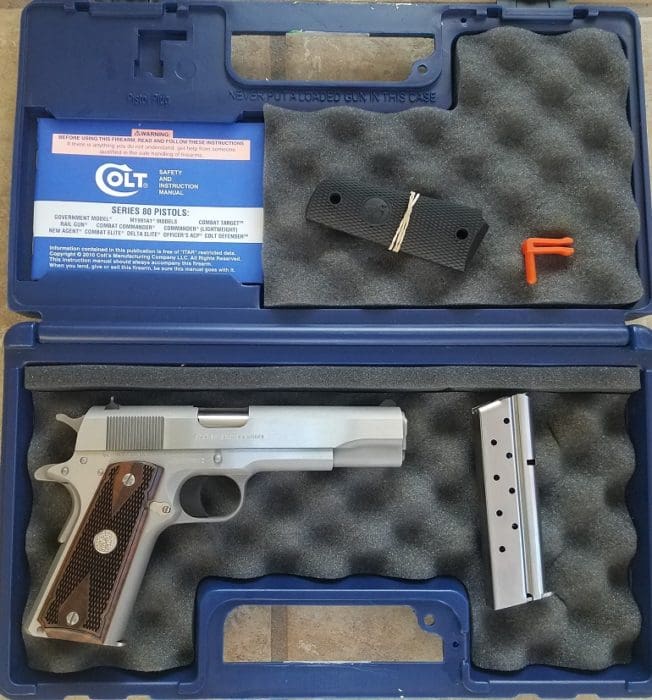
The Colt Series 80 Government is the quintessential basic model 1911. I think it’s the best raw material for customization out there, at least if you want a gun and not just parts. In .38 Super it’s a light-recoiling, super-accurate and reliable firearm. This particular one just happens to be beautiful as well. I’ll checker the front strap and change the sights, and not much else. After that, it may become my new EDC.
Specifications: Colt Series 80 Government
Barrel Length: 5”
Sights: 3-Dot
Weight: 41.5oz
Overall Length: 8.5”
Safety: Thumb safety, Grip Safety, Firing Pin Safety
Grips: Crappy weak rubber
Finish: Brushed Stainless Steel
Caliber: 38 Super
Capacity: 9+1
Magazines: two included
Price: $750 (Found online between $750 and $799)
Style and Appearance * * * *
Throw away the grips. After that, it’s a great looking gun. The classic lines of the 1911 are fully realized in the USGI style, and Colt doesn’t screw it up with too large a roll mark or front serrations. This particular gun is unusually well polished but there are some mild internal errors.
Customization * *
With enough money, you can change anything and everything on a Colt 1911. But it will cost you.
Reliability * * * * *
The gun ran like a spotted-ass ape.
Accuracy * * * * *
Sub 1” groups from cheap ammo. I did not see that coming.
Overall * * * *
This pistol is a good step above the average basic Colt 1911. The accuracy is outstanding, the reliability is perfect. It’s also a great looking gun. Those grips were an abomination to John Moses Browning (praise his name.) Unfortunately, and predictably, Colt no longer makes this basic model (O2091) in .38 Super. You’ll have to pay double the price for the same gun now, but with a high polish. Still, this gun was brand new when I bought it last month, and a quick internet search found several more available with retailers around the country, all for around what I paid for this one.

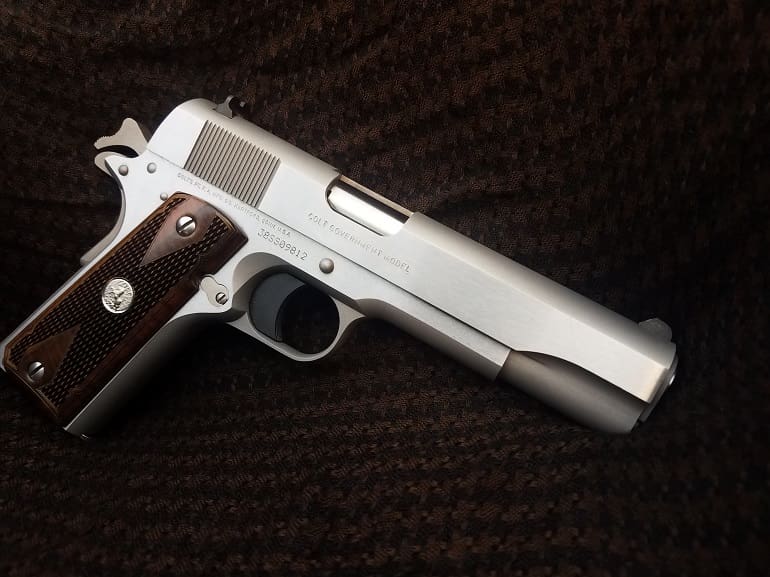



Not your typical Series 80 at all. Someone took a little time with this one. It’s the only recent Colt I’ve seen where the grip screw bushings were installed to allow the grip screws to align both with each other and with the grip angle. This was pretty common in the ’50/’60 models. I laugh when I see most of the very high dollar, name brand 1911A1s advertised with this little feature skipped. It’s a small thing, takes maybe an hour to line everything up, but I think it’s these kind of old time details that make or break a custom or semi-custom firearm. Congratulations on a great find. -30-
Dyspeptic has griped on the lack of screws being properly ‘timed’ on supposedly-premium firearms before. He was kind enough to describe the process for doing that work, and it isn’t very difficult. Just as you mentioned, a bit time-consuming. On supposedly-premium things, the details *do* matter…
It drives me crazy. My Wilsons, my Ed Browns, my Les Baers, none of them came with the screws timed. It just drives me nuts. Even worse is when they come without traditional slot head screws. I’ve given away a few 1911s as gifts, and I always make sure to put in the correct screws and time them before I give them away.
“Even worse is when they come without traditional slot head screws.”
It’s probably me, but Torx, for example, instead of properly-timed slot screws wouldn’t bother me that much. Especially on a stainless gun like that. It would ‘blend in’ well.
It’s the lack of symmetry in appearance of un-timed slot screws that bugs me in supposedly high-end firearms…
The only tool I used to put those grips on that gun was the shell casing. I can’t do that with a Torx.
Unlike many other gun stores, the Cabelas gun library in Buda, Texas allows prospective buyers to disassemble the firearm. At least they do for me and I’ve seen others do it as well. They’ll even let you borrow a magnifying glass and a light. I did a complete, and yes, I do mean complete, disassembly of this gun prior to purchase.
There are a few mistakes with the gun, but as I inspected it, I noticed several things on the gun outside of the average quality. It’s like they were working a custom gun, stopped partway through the process, and put it back on the line.
There is another theory, posited by the guy that runs the gun library there (we are friends, kind of like a regular John is a hooker’s best friend). He says that Colt puts special attention to all of their 38 Super guns, knowing that most people purchase them for competition. Maybe, maybe not.
Did you experience the trigger press on this specific piece before or after the 4473 was passed? Last I went to Cabela’s they wouldn’t allow the trigger to be unlocked until after a successful 4473 due to a suicide at different corporate location.
Yes, I was able to dry fire it several times. They run the gun library a little different than they do the counter.
A successful 4473 indicates a non-suicidal customer? WTF?
It’s 2018, right? Can we stop with the 1911/1911A1 crap grip safety now? There is no reason for companies to put this sort of grip safety on a current mfg gun unless it’s supposed to be a “REPO” or “Classic” type gun.
Colt, you still suck. Catch up!
Interesting. I actually assumed this was a used piece. JWT?
New in box.
I think the grip safety’s are cool, I like having a firearm with multiple safeties,anyway the ones that work like a 1911’s. My main bitch about Glock the No Safety saftey, like carrying around a cocked double action revolver.Well not quite, because you’ve got to pull a Glock trigger to the north 40 before it goes of.
Better a grip safety than one of those abortions of a trigger safety on “modern” striker fired pistols.
I have a Canik with just a blade safety on the trigger. That little blade does not inspire confidence. http://www.canikusa.com/tp9sf-elite/
I had a chance (in the People’s Republic of MA) to buy a blued .38 Super. There was only one and I jumped at the chance.
I read about the cartridge in one of Cooper’s columns from the 70s explaining how it was popular south of the border (non-military could only have non-mil calibers). I ended up using for bowling pin shoots at my club.
The gun shoots well enough for my skill level. The finish is horrible. Lots of rough spots and tool marks. Still, I didn’t get it as a BBQ gun (although I switched the stocks for a nice smooth wood pair).
To all y’all gun sellers out there: am I the only one to notice that the only customers who ever mention .38 Super are invariably of Mexican descent or recently immigrated? Every. Single. One.
🤠
I’m not Mexican.
I assume most people here have forgotten more about guns than I’ll ever know so could you explain the importance of screw timing. Also, eventually l want what l call a lookatitgun. An example would be a 5 grand Wilson Combat. When l order that lookatitgun must l request proper screw timing?
I’m a big fan of Wilson, but…yup, I’d say make sure you ask for it.
As far as my knowledge of 1911s, I’d say I’ve graduated from “novice” to “amateur”. I can, and have cut slides for sights, installed hammers, safeties, triggers, and mainspring housings. I’ve put in the Kart “easy fit” barrels (holy crap those are awesome.) I’ve deburred, leveled parts, and done some basic polishing. I’ve checkered.
What’s great is, all of that can be done pretty much just with the Jerry Kuhnhausen shop manuals, time, and the willingness to destroy nice things. That’s the beginning of the work that’s possible on a 1911.
I had to decide, at one point, do I want to work on guns or do I want to shoot them, because there’s not really time to do both. At this point in my life, I’ve settled on shooting them, with occasional project guns. According to my log, it looks like this will be another 30,000 round year.
Crap, I forgot to answer you actual question.
Most manufacturers screw the scales on the grips, and the slots on the screws end up wherever they end up. For instance, take a look at Wilson Combat’s best selling pistol, the CQB Elite.
https://www.wilsoncombat.com/cqb-elite/
Note the slots just end up wherever. That’s a $3,400 gun.
Now take a look at the ones in the photos in this article. Note, they aren’t actually perfect, but much closer to aligning themselves with the axis of the grip itself. That wasn’t an accident. Getting all 4 screws to do that at random would be extremely unlikely. Someone did it on purpose.
This alignment serves no functional purpose. It simply shows attention to detail and pride in workmanship.
Other than attention to detail and pride in workmanship, why would anyone spend 4x as much for anything?
Geoff, you can’t see it but that made me put my finger on my nose.
*snicker* 😉
I seem to recall, (or maybe I dreamed it), that because 45acp was a military caliber, it was not legal for civilian use in Mexico. The 38 super in a 1911 was the top desirable and powerful handgun available to Mexican civilians back in the day. If true that might account for your observation. If it’s not true, I imagine someone will let me know, and prevent me from spouting more bs.
I’ve always heard that as well, but I can’t keep track of Mexico’s firearms laws. At one time the maximum allowable cartridge was .38 Special, but I don’t know about now.
Seem to remember reading just that in a Jeff Cooper article, i’mna thinking was in G&A, late 60’s, early 70’s.
Thank you for the reply JWT. And Gov, l would spend 3 or 4 times the money because l can. I would ask a friend who is a magician with wood to make a presentation case and when I drop dead it will go to my daughter who might not ever shoot it but appreciates beautiful things.
“Title Two of the [Mexican] Federal Law of Firearms allows possession and carrying of handguns in a calibers of .380 or less, although some calibers are excluded, most notably .357 magnum and 9mm parabellum.”
Source: http://www.davekopel.org/Espanol/Mexican-Gun-Laws.htm
So that means .38 Super is the most powerful pistol caliber a Mexican civilian can legally own. That probably gave it the same kind of reputation that the .45 ACP has in the U.S.A.
Makes sense. Thank you.
Great find!
That thing looks brand new.
I’m also a lover of the .38 super.
It was new. Now it’s got about 1,000 rounds through it.
I’m black bear hunting here in a couple of weeks (again). I’m wondering how hard I can push a 158gr LSWC for just a magazine’s worth of ammunition, and still be safe.
Not for the hunt itself, just for backup.
“the old wheelgun”
The .38 Super is older than the .357 Magnum…
By 5 years, yes. That doesn’t make the 84 year old revolver cartridge young.
I am certain that everyone here already understands that the .357 magnum is the penultimate magical cartridge to end all research. How could anything be better? .357 Sig is an excellent adaptation for those who do not understand the absolute necessity for a wheel in your gun.
‘…with the 125gr load, both the .38 Super and the .357 Magnum can generate equal velocities with the same barrel length.’
When I first read this I assumed I was reading another ‘just as powerful as a .357’ claim, which it wasn’t. But it got me off on a tangent so I’ll share.
I compared case capacities of .38 super vs .357 magnum (1.14cm3 vs 1.7cm3), max pressure (35,000psi vs 36,500psi) and compared the necessary bullet seating depth, since the .38 allows for 9.65mm of exposed lead vs 7mm for the .357. When all the numbers are crunched using a bullet .56″ long (124-125gr) seated as far out as possible there’s about 45% more volume left for powder in the .357 and compensating for the lower max pressure that still leaves 39% more powder behind the .357 bullet.
Which is just about right. Usually the hotter loads in .38 super run around 525ft/lbs ME out of a 5″ barrel while the hot (but not +p) loads in .357 will clear 700ft/lbs from a 4″ vented barrel. So the .38 can keep up with the milder but more common .357 factory loads, but to run with the full pressure .357 loads you would have to run it up to 50,000+psi.
It’s worth noting that a 5″ barreled 1911 only has 4.1″ of actual barrel.
Typically when comparing vented to non-vented barrels in a given round, the mid length barrels will yield similar results while the snubbies will do better and long vented barrels do worse due to the time energy has to bleed out the cylinder gap. A 5″ Coonan for instance will yield similar velocities as a 5″ revolver. On the other hand a 9mm LCR (1-7/8″) will get about what you’d expect out of a 3″ semi-auto.
When comparing weapons, a 3″ revolver is about the same as a 4″ semi-auto for carry since the slide is about the same as the barrel and cylinder (similar sight radii as well). The revolver grip does angle back more, but that doesn’t seem to matter for carry, IMHO.
Glock needs to do a pistol in this caliber. So does S&W. And Ruger. If any of them did, I wouldn’t have bothered with 357Sig at all.
On a Ruger 1911 in 9mm (or any 9mm 1911) a 9X19 to .38 Super swap is simple. I’m having that done to one of my Wilsons right now. When you are done you can go back and forth in about 3 minutes.
JWT, please explain the details for this conversion.
(Knowing that it will cost me yet again & divert my ADD mind to another project.)
Thnx!
Fit new Barrel. Put in new extractor. Maybe change the recoil spring if you’re going to be pushing the heavy stuff. That’s it.
You should expect to pay anywhere from 300 to $400 for that work.
Outstanding review, Mr. Taylor. You made me want one !
Thank you sir.
JWT, an excellent purchase and a great article as well. Thanks for such an informed read. Now I also have the .38 Super itch!/
An interesting fact about JMB is, he died before the HiPower was finished because he’d seen what a fine pistol he’d developed for such a pathetic cartridge. It just killed him.
My grandfather swore by .38 Super. Only auto he owned.
Very popular south of the border.
Am I the only one who thinks when the military left the m9 they should’ve switched to .38 super? Because that’s what I wanted to see happen.
The gun appears to have a “junk” plasticky trigger. The flats on the slide are not high polish but then again I have not seen this anymore on any of the brands of newly made 1911’s. One more reason I do not buy modern made trash.
Not a plastic trigger and the sides are not supposed to be high polished on the ‘brushed stainless” model.
Thanks for playing, better luck next time.
Put your glasses on the trigger is plasticky. And I am not just beating up on Colt as all the 1911 Manufacturers have went to the “junk” rough finish on their slides as it would cost them a few pennies more to put a quality finish on a gun these days. They are all guilty of pandering low grad junk to the public. And we never discussed the junk “MIM” brittle cast internal parts. Now I suppose you will next deny the gun has these too and that they do not have such a high failure rate? Just what you need if you ever had to depend on a gun, a junk MIM cast part failing you at the critical time.
So by “plasticy” you mean metal with a light crisp break. Got it. As it states in the article, you can buy a high polished one if you want.
I would be happy to discuss MIM parts, but you’ve already lost your credibility with me.
Sorry Taylor it is you that are delusional not me. And you finally admitted the gun does have MIM cast parts and then say , “not to worry”, it only has a few junk MIM cast parts that will fail. Well the reality is if just one of those junk parts fails at a critical moment you get yourself killed in a gun fight. I am willing to bet your carry gun does not have MIM cast parts in it and if it does then you really are a fool. By the way how much money does the gun industry pay you for making yourself look so bad in this discussion. MIM cast parts failures are well known, its not like this is a new discussion on the subject.
No I mean a junk plastic trigger. And lets discuss junk MIM cast parts.
Again. The trigger is not plastic. It is metal. There are two different triggers offered in these models, steel and aluminum. Those are metals.
As far as the rest of your diatribe on MIM parts, you have some of the most basic nomenclature and parts wrong.
The Series 80 gun has 4 MIM parts. That’s it. This is not 1970. They last. They are not brittle. There is no need to replace them. Tens of thousands of rounds later, my Colts with MIM parts are still going strong.
Now since I am sure we will never hear from you again I will continue the discussion anyway. Colt had so many guns returned for repair when they first went over to the “junk” MIM cast parts they then tried mixing forged pats with junk MIM cast parts. One of the major failures were the hammer and sear so they decided to use one good part with one junk part hoping that the junk MIM cast part would last a little longer before it went snap, crackle and pop. Brilliant. Excuse me while I barf.
Now lets look as Smith & Wesson. Their die in the wool fans went out of their minds when they went over to the junk MIM cast parts as trigger pulls were so gritty it would make an off brand Saturday night special gun of the 60’s look like a Cadillac of firearms. When you take a cast part right out of the mold and slap it in a gun what else would you expect.
Seecamp which as far as I know is till in business and posted for all to see the fact that they have consistently refused to use junk MIM cast parts simply because they are junk
and they make no bones about it. They boldly state “we build quality guns not junk”.
Ditto for the Detonics Company who some years ago on one of the Cable gun shows proudly told the interviewer “we refuse to use MIM cast parts in our guns”. Well I wonder why? As if we did not already know why.
MIM cast parts are powdered metal dust mixed with plastic and formed under pressure to very tight tolerances so no machining is necessary. They come out of the mold and are slapped right into the frame of the gun. The problem is that when these parts are formed under pressure the plastic melts and this forms even bigger porosity (polite word for air holes) than traditional castings which are bad enough already. MIM only makes the situation far worse making the part even more brittle than traditional junk castings. Its all done to save money and fk the consumer and fk the consumer it surely does. With all the horror stories on the internet about MIM cast part failures (some of them even from gunsmiths) even if only 1 per cent of them were true we see that MIM cast parts are not something to trust your life too unless you want to start changing out parts every couple of thousand rounds if you even get that far.
Yea sure I believe you just like one of my buddies who said much the same about how he trusted MIM cast parts. When I was over his home one day the gun he had by his beside was one that had no junk MIM cast parts in it. There is an old saying, “Believe not in what a person who works for the gun industry says but believe in what he actually does”.
How much does the gun industry pay you to post such nonsense about putting thousands of rounds through a hand gun with MIM cast parts. MIM cast parts do not last long when put under pressure. Even when only the safety is made of MIM cast parts it takes only a hard bump to shatter it. I once saw a fellows handgun dropped only about 12 inches onto a wooden shooting bench and the safety which was made of a junk MIM cast part shattered even though it only hit the wooden table from 12 inches up. That was proof enough for me. As the Chinese say “one picture is worth a thousand gun writers words of profit propaganda”. When your life is on the line use only what has worked in the past not what “might work” in the future because the company that made it was trying to make a few pennies more in profit.
In conclusion most modern made guns equal junk, as they are made faster, faster, and cheaper , cheaper, stick with the classics, they are “real guns”. I had enough plastic squirt guns as a kid to show me how cheap they were and still are. I just got done watching “Shooting USA” and one of the hosts that was shooting a Colt Woodsman looked right into the camera and said “This is a real gun made of forgings” not a piece of plastic.
A buddy of mine has a Colt 1911 National Match gun he paid a lot of money for, and it has a junk plastic main spring housing and a junk plastic trigger. Maybe you cannot tell the difference between metal and plastic but for me I have been around enough years that its a no-brainer. Next you will be telling us this cannot possible be true so I suggest you actually examine some of these Colts and if you still cannot tell the difference use a small magnet. Unlike Gun writers magnets cannot lie.
Where do you come up with this crazy shit? Again, get it through your head, the trigger is metal. I have 7 Colt 1911s. If you are unwilling to believe the hundreds of parts catalogs, the product descriptions from dozens of sources, books, videos, and every gunsmith that works on them, and you don’t actually own one that you can pull apart, I don’t know what to tell you, other than you are clearly delusional. Please stop telling people things about guns. You have no idea what you are talking about.
Damn dude, you have some serious issues, maybe go see an “mim” doctor or something 😂😂.
You didn’t buy it, it’s not hurting you so what’s your problem?
I don’t like mim parts either but I’m not gonna whine about them like you, I simply replace what’s needed. See how easy that is?
Nope, you’ve got to get your panties all in a bunch and make a democrat out of yourself online. Pretty funny reading your senseless posts where you’re working yourself into an upcoming stroke😂😂😂.
All because of something YOU DONT OWN😂😂😂
This is meant for the guy whining about mim parts.
You don’t have real friends do you? Just your imaginary MIM friends that live inside your head, pretty much it huh? For you to sit there and tell the writer what type of trigger he has when I know damn well it’s either aluminum or steel because I own one just makes you out to be a complete idiot. Big time.
Problem is, you already know this so it’s nothing new.
Not sure if you haven’t been laid in awhile or what but you’ve got some very serious issues. Especially when it comes to calling people liars basically, that alone makes you delusional in my opinion which you clearly are as demonstrated in your nut case ranting posts. I’ll bet you buy MIM parts all the time, you just pretend to not like them because you can’t tell the difference 😂😂😂
Go away to your fantasy land and have fun fighting inside your own head because you are gone dude. I mean way the hell out in left field GONE!!!!!!!!!
Series 80 Pistols suck because of that firing pin issue when all that was required was a heavier firing pin spring! no they over complicated the issue by adding more parts into the trigger firing cycle which in turn makes it much harder to get a descent trigger Job! They were Too cheap to pay royalties on a firing pin safety like the Spanish clones had or the Kimbers have today
Having put together a few 1911’s the Series 70 is a better Pistol
Waaah
I purchased a government model .38 super at a small gunshop near where I live. It is blued and colt royal blue is great. It had one previous owner who didn’t shoot it much. It shoots and functions great with different brands of ammo. It is definitely a keepr.
If you love to wear vests? so get this amazing Red Puffer Vest which is a favorite of all girls and it is the most-rated and most selling outfit in our store, shop now because the stock is limited.
WTF does this have to do with a 38 super? Vests?😂😂😂🇺🇸